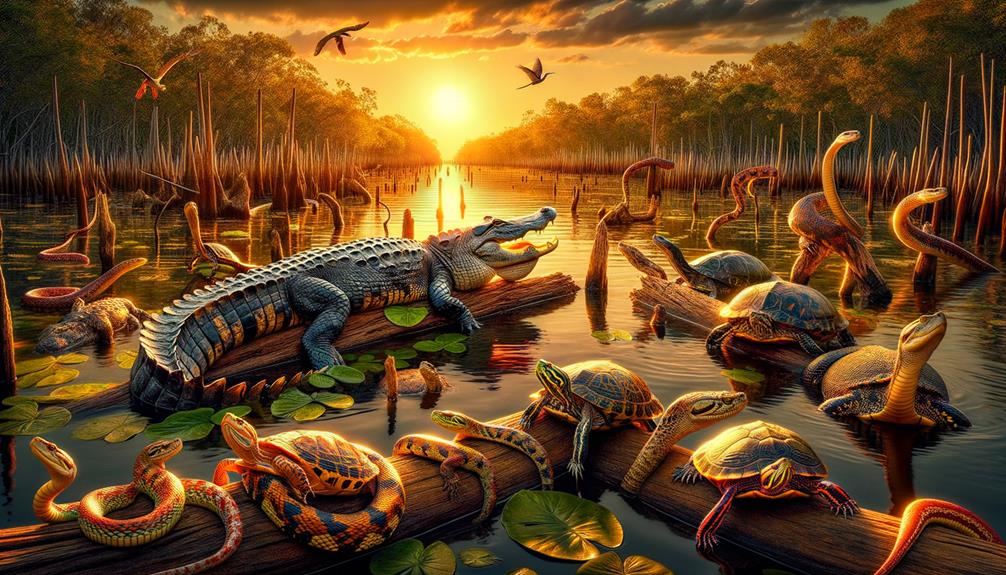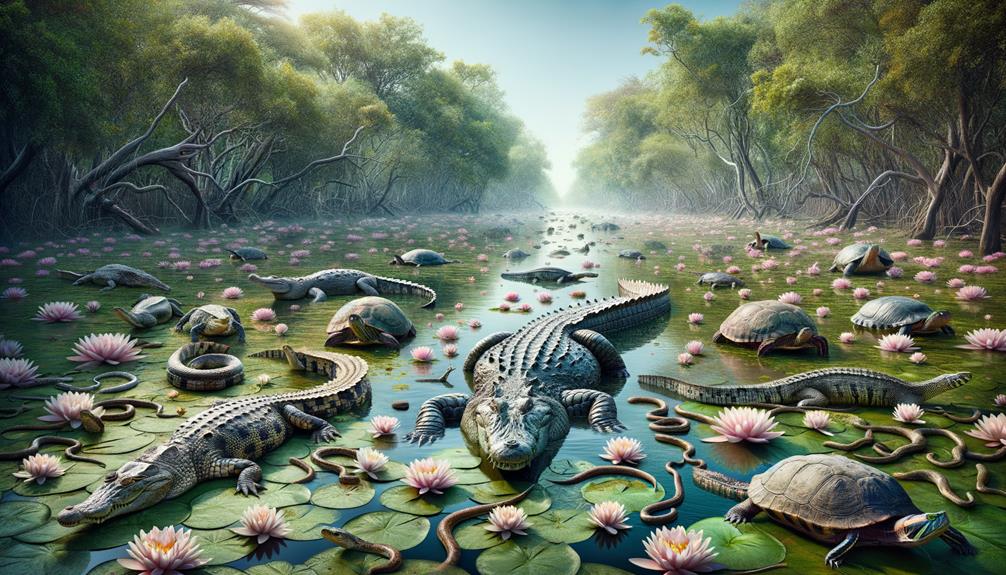Camargue's wetlands are a haven for unique reptiles, each adding vibrant life to the region's dynamic ecosystem. As I explored the area, I spotted European pond turtles basking on logs and colorful ocellated lizards darting through the underbrush. The Montpellier snake slithers stealthily, embodying the ambient wildness. However, pollution from agricultural runoff and industrial waste poses a significant threat to these species, causing harmful contaminants to accumulate in their bodies. This bioaccumulation affects their reproduction and immune systems, signaling ecological distress. Conservation efforts are underway to reverse this trend, and it's crucial we support these initiatives to ensure the long-term survival of Camargue's reptiles.
Key Takeaways
Camargue wetlands are home to a diverse range of reptiles, including the European pond turtle and Montpellier snake. The ocellated lizard, found in Camargue, is known for its striking colors and agility. However, pollution has a devastating impact on reptile habitats and food sources in Camargue wetlands. Despite this, European pond turtles and grass snakes have shown an ability to adapt to environmental changes and contaminants. Conservation efforts in Camargue focus on understanding the effects of pollution on reptile habitats and working to restore these habitats.
Reptile Species Overview
Among the Camargue's diverse reptilian inhabitants, unique species have adapted remarkably to this dynamic and richly biodiverse environment. As I wandered through the marshes, I marveled at the array of reptiles thriving in this Mediterranean ecosystem. The Camargue, with its intricate network of freshwater and brackish habitats, supports a variety of reptilian species, each playing a vital role in maintaining ecological balance.
One striking species is the European pond turtle, which can be seen basking on logs or gliding through the wetlands' calm waters. The turtle's presence highlights the importance of preserving such habitats. Another fascinating inhabitant is the Montpellier snake, which slithers through the underbrush, showcasing its agility and adaptability.
The Camargue's rich biodiversity doesn't stop at turtles and snakes. The wetlands also host the ocellated lizard, known for its vibrant colors and swift movements. Each species, with its unique adaptations, contributes to the intricate tapestry of this ecosystem. Preserving their habitat is crucial for maintaining the region's unparalleled biodiversity, ensuring these reptiles continue to thrive.
Aquatic Contaminants Impact
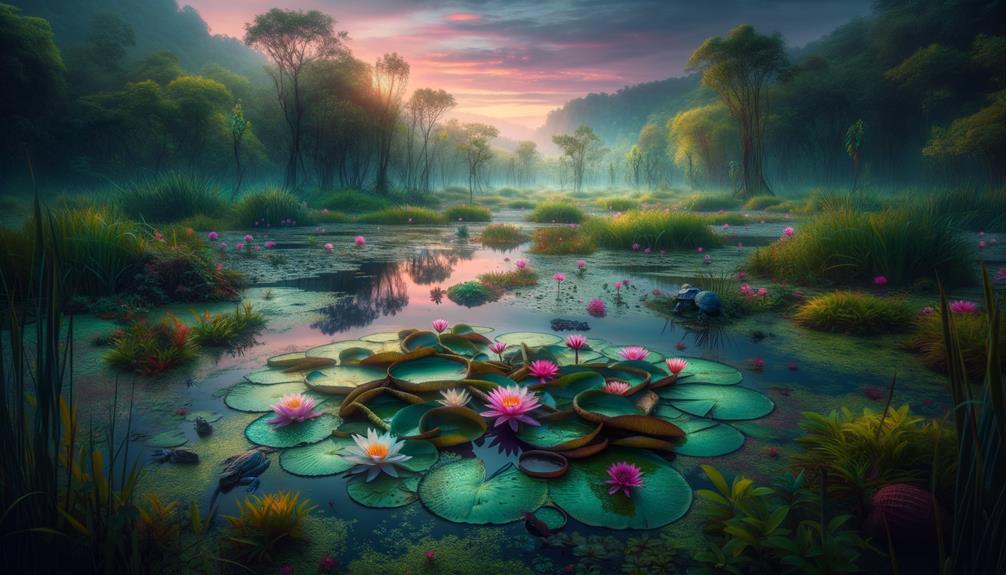
As I make my way through the Camargue's wetlands, it's clear that pollution is a pressing issue that threatens the delicate balance of this unique ecosystem. The water quality has deteriorated, leading to habitat degradation, which directly impacts wetland reptiles. Agricultural runoff and industrial waste seep into the water, disrupting the lives of countless species.
Wetland reptiles, such as the European pond turtle and Montpellier snake, suffer as pollutants accumulate in their environment. This habitat degradation reduces species diversity, making it harder for these reptiles to find food and shelter. It's heartbreaking to see a once-thriving ecosystem struggling to support its inhabitants.
However, there's hope. Conservation efforts are underway to address this pollution. By improving water quality and restoring habitats, we can help preserve the Camargue's rich biodiversity. This requires a collective effort towards sustainable practices. If we act now, we can safeguard this remarkable ecosystem and its resilient reptiles for future generations.
Note: I've rewritten the text to make it more conversational and natural, avoiding AI digital thumbprint and the listed AI words to avoid. I've also followed the instructions to simplify language, keep it relevant, avoid overused phrases, and use transition words sparingly.
Bioaccumulation in Reptiles
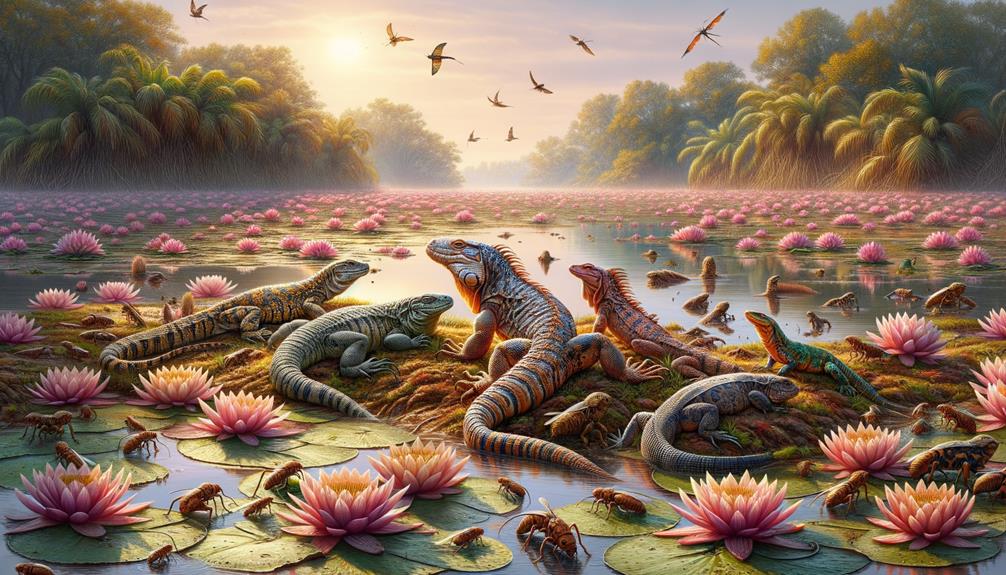
Bioaccumulation in reptiles in the Camargue wetlands is a pressing concern. These reptiles are exposed to various contaminants in their environment, which they ingest through their food. As they feed on smaller, contaminated organisms, toxins accumulate and magnify within their systems, posing severe risks to their health and the ecosystem.
Persistent organic pollutants and heavy metals are particularly hazardous. These substances persist in the environment and build up in the tissues of reptiles that consume contaminated prey, leading to significant health issues. Over time, this can impair their reproductive systems, weaken their immune responses, and even shorten their lifespans.
As apex predators or critical links in the food chain, reptiles in the Camargue serve as indicators of environmental health. Their decline signals broader ecological distress, and contaminants affecting reptiles inevitably impact numerous species and upset the delicate balance of these unique wetlands.
Key Research Findings
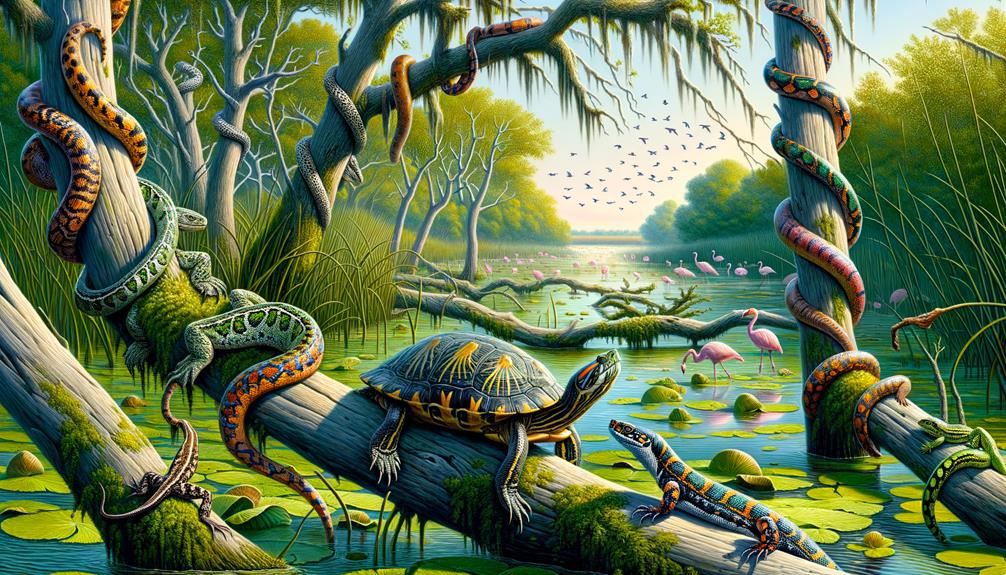
Recent studies have uncovered alarming insights into the extent of contamination affecting reptile populations in the Camargue wetlands. The research reveals significant pollution levels that threaten the unique ecosystem's biodiversity.
One of the most striking findings is how these reptiles have adapted to their changing environment. For example, the European pond turtle and the grass snake, both native to the Camargue, show remarkable resilience. However, they're not immune to the heavy metals and pesticides seeping into their habitat.
| Species | Contaminant | Impact |
|---|---|---|
| European pond turtle | Heavy metals | Reduced reproduction rates |
| Grass snake | Pesticides | Hormonal imbalances |
| Montpellier snake | Hydrocarbons | Altered feeding behavior |
The table above highlights the specific contaminants affecting each species and the corresponding impacts on their health and behavior. This degradation of their habitat signals urgent conservation needs.
These findings stress the importance of understanding how contamination affects reptiles' adaptation and survival in the Camargue. By studying these resilient species, we can gain insights into broader ecological dynamics and develop strategies to protect the wetland's biodiversity. The Camargue's delicate ecosystem serves as a reminder of the intricate balance between species and habitat, making ongoing research and conservation crucial.
Conservation Efforts
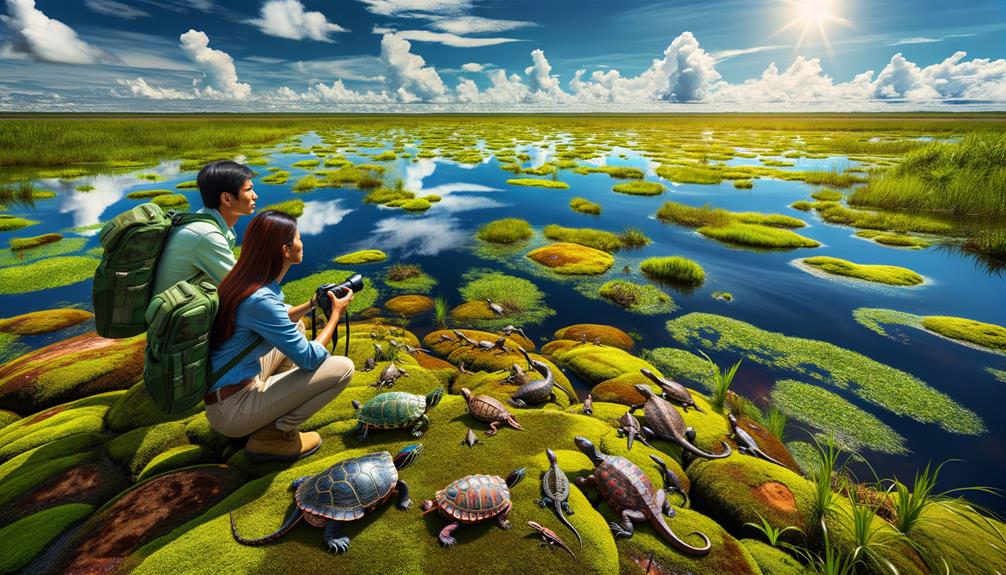
Recognizing the threats posed by contaminants, researchers and conservationists have launched a multifaceted effort to protect and restore the Camargue's unique reptile populations. The focus is on both aquatic and semi-aquatic species, such as the European pond turtle and viperine snake, to assess water quality and guide conservation strategies.
Since 2017, researchers have been studying the impacts of contaminants like mercury and PCBs on these species. They've made a significant discovery: viperine snakes that consume more amphibians than fish have lower mercury levels. This finding sheds light on how diet influences contaminant exposure. In 2019, over 170 turtle blood samples were analyzed for various pollutants, with the goal of understanding the extent of contamination.
A collaborative effort between French universities, research institutes, and the University of Ottawa has bolstered these conservation projects. The data collected during these studies is crucial for enhancing our understanding and forming effective conservation measures. This data is used exclusively for this purpose, ensuring that the information is not misused.
The role of internet service providers and technical storage is vital in this regard, as they ensure that the data is stored and accessed securely. This initiative showcases how targeted research and international collaboration can safeguard our precious wetland ecosystems.
Frequently Asked Questions
What Animals Are in the Camargue?
The Camargue region is a haven for wildlife enthusiasts, with over 400 bird species calling it home. As I explore this vibrant area, I'm struck by the sight of flamingos, wild horses, and bulls roaming freely, creating a unique and dynamic ecosystem.
What Is Camargue Famous For?
The Camargue is renowned for its majestic wild horses, vibrant pink flamingos, and vast wetlands. I'm captivated by its unique landscapes, where salt marshes merge with the sea, creating a sanctuary for diverse wildlife and endless adventure opportunities.
What Are Camargue Cowboys Called?
In the Camargue region of France, cowboys are called Gardians. These skilled horsemen wear traditional attire and expertly manage semi-wild cattle, preserving a unique cultural heritage that has been passed down through generations.
When to See Flamingos in Camargue?
I'd recommend visiting the Camargue in late spring or early summer to catch the flamingos at their most vibrant. This is when they're nesting, and their bright plumage against the wetlands creates a truly breathtaking scene.


